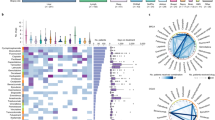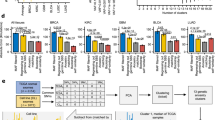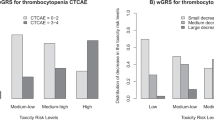Abstract
Platinating agents are used in the treatment of many cancers, yet they can induce toxicities and resistance that limit their utility. Using previously published and additional world population panels of diverse ancestry totaling 608 lymphoblastoid cell lines (LCLs), we performed meta-analyses of over 3 million single-nucleotide polymorphisms (SNPs) for both carboplatin- and cisplatin-induced cytotoxicity. The most significant SNP in the carboplatin meta-analysis is located in an intron of NBAS (neuroblastoma amplified sequence; P=5.1 × 10−7). The most significant SNP in the cisplatin meta-analysis is upstream of KRT16P2 (P=5.8 × 10−7). We also show that cisplatin-susceptibility SNPs are enriched for carboplatin-susceptibility SNPs. Most of the variants that associate with platinum-induced cytotoxicity are polymorphic across multiple world populations; therefore, they could be tested in follow-up studies in diverse clinical populations. Seven genes previously implicated in platinating agent response, including BCL2 (B-cell CLL/lymphoma 2), GSTM1 (glutathione S-transferase mu 1), GSTT1, ERCC2 and ERCC6, were also implicated in our meta-analyses.
This is a preview of subscription content, access via your institution
Access options
Subscribe to this journal
Receive 6 print issues and online access
$259.00 per year
only $43.17 per issue
Buy this article
- Purchase on Springer Link
- Instant access to full article PDF
Prices may be subject to local taxes which are calculated during checkout





Similar content being viewed by others
References
Borghaei H, Langer CJ, Millenson M, Ruth KJ, Litwin S, Tuttle H et al. Phase II study of paclitaxel, carboplatin, and cetuximab as first line treatment, for patients with advanced non-small cell lung cancer (NSCLC): results of OPN-017. J Thorac Oncol 2008; 3: 1286–1292.
McWhinney SR, Goldberg RM, McLeod HL . Platinum neurotoxicity pharmacogenetics. Mol Cancer Ther 2009; 8: 10–16.
Micheletti E, La Face B, Bianchi E, Cagna E, Apostoli P, Ruggeri G et al. Continuous infusion of carboplatin during conventional radiotherapy treatment in advanced squamous carcinoma of the cervix uteri IIB-IIIB (UICC). A phase I/II and pharmacokinetic study. Am J Clin Oncol 1997; 20: 613–620.
Rabik CA, Dolan ME . Molecular mechanisms of resistance and toxicity associated with platinating agents. Cancer Treat Rev 2007; 33: 9–23.
Siddik ZH . Cisplatin: mode of cytotoxic action and molecular basis of resistance. Oncogene 2003; 22: 7265–7279.
Wang D, Lippard SJ . Cellular processing of platinum anticancer drugs. Nat Rev Drug Discov 2005; 4: 307–320.
Celik I, Kars A, Ozyar E, Tekuzman G, Atahan L, Firat D . Major toxicity of cisplatin, fluorouracil, and leucovorin following chemoradiotherapy in patients with nasopharyngeal carcinoma. J Clin Oncol 1996; 14: 1043–1044.
van Glabbeke M, Renard J, Pinedo HM, Cavalli F, Vermorken J, Sessa C et al. Iproplatin and carboplatin induced toxicities: overview of phase II clinical trial conducted by the EORTC Early Clinical Trials Cooperative Group (ECTG). Eur J Cancer Clin Oncol 1988; 24: 255–262.
Peters U, Preisler-Adams S, Hebeisen A, Hahn M, Seifert E, Lanvers C et al. Glutathione S-transferase genetic polymorphisms and individual sensitivity to the ototoxic effect of cisplatin. Anticancer Drugs 2000; 11: 639–643.
Oldenburg J, Kraggerud SM, Brydoy M, Cvancarova M, Lothe RA, Fossa SD . Association between long-term neuro-toxicities in testicular cancer survivors and polymorphisms in glutathione-s-transferase-P1 and -M1, a retrospective cross sectional study. J Transl Med 2007; 5: 70.
Peters U, Preisler-Adams S, Lanvers-Kaminsky C, Jurgens H, Lamprecht-Dinnesen A . Sequence variations of mitochondrial DNA and individual sensitivity to the ototoxic effect of cisplatin. Anticancer Res 2003; 23: 1249–1255.
Riedemann L, Lanvers C, Deuster D, Peters U, Boos J, Jurgens H et al. Megalin genetic polymorphisms and individual sensitivity to the ototoxic effect of cisplatin. Pharmacogenomics J 2008; 8: 23–28.
Oldenburg J, Kraggerud SM, Cvancarova M, Lothe RA, Fossa SD . Cisplatin-induced long-term hearing impairment is associated with specific glutathione s-transferase genotypes in testicular cancer survivors. J Clin Oncol 2007; 25: 708–714.
Ross CJ, Katzov-Eckert H, Dube MP, Brooks B, Rassekh SR, Barhdadi A et al. Genetic variants in TPMT and COMT are associated with hearing loss in children receiving cisplatin chemotherapy. Nat Genet 2009; 41: 1345–1349.
Wu X, Ye Y, Rosell R, Amos CI, Stewart DJ, Hildebrandt MA et al. Genome-wide association study of survival in non-small cell lung cancer patients receiving platinum-based chemotherapy. J Natl Cancer Inst 2011; 103: 817–825.
Hartford CM, Duan S, Delaney SM, Mi S, Kistner EO, Lamba JK et al. Population-specific genetic variants important in susceptibility to cytarabine arabinoside cytotoxicity. Blood 2009; 113: 2145–2153.
Huang RS, Duan S, Kistner EO, Hartford CM, Dolan ME . Genetic variants associated with carboplatin-induced cytotoxicity in cell lines derived from Africans. Mol Cancer Ther 2008; 7: 3038–3046.
Huang RS, Duan S, Shukla SJ, Kistner EO, Clark TA, Chen TX et al. Identification of genetic variants contributing to cisplatin-induced cytotoxicity by use of a genomewide approach. Am J Hum Genet 2007; 81: 427–437.
Li L, Fridley BL, Kalari K, Jenkins G, Batzler A, Weinshilboum RM et al. Gemcitabine and arabinosylcytosin pharmacogenomics: genome-wide association and drug response biomarkers. PLoS One 2009; 4: e7765.
Watters JW, Kraja A, Meucci MA, Province MA, McLeod HL . Genome-wide discovery of loci influencing chemotherapy cytotoxicity. Proc Natl Acad Sci USA 2004; 101: 11809–11814.
Niu N, Schaid DJ, Fridley BL, Kalari K, Li L, Jenkins G et al. Oral session III-B (OIII-B) molecular targets and genetics in oncology 9:30 am - 10:30 am. Clin Pharmacol Ther 2011; 89: S66–S68.
Ziliak D, O’Donnell PH, Im HK, Gamazon ER, Chen P, Delaney S et al. Germline polymorphisms discovered via a cell-based, genome-wide approach predict platinum response in head and neck cancers. Transl Res 2011; 157: 265–272.
Altshuler D, Brooks LD, Chakravarti A, Collins FS, Daly MJ, Donnelly P . A haplotype map of the human genome. Nature 2005; 437: 1299–1320.
Frazer KA, Ballinger DG, Cox DR, Hinds DA, Stuve LL, Gibbs RA et al. A second generation human haplotype map of over 3.1 million SNPs. Nature 2007; 449: 851–861.
O’Donnell PH, Gamazon E, Zhang W, Stark AL, Kistner-Griffin EO, Stephanie Huang R et al. Population differences in platinum toxicity as a means to identify novel genetic susceptibility variants. Pharmacogenet Genomics 2010; 20: 327–337.
Altshuler DM, Gibbs RA, Peltonen L, Dermitzakis E, Schaffner SF, Yu F et al. Integrating common and rare genetic variation in diverse human populations. Nature 2010; 467: 52–58.
de Bakker PI, Ferreira MA, Jia X, Neale BM, Raychaudhuri S, Voight BF . Practical aspects of imputation-driven meta-analysis of genome-wide association studies. Hum Mol Genet 2008; 17: R122–R128.
Willer CJ, Li Y, Abecasis GR . METAL: fast and efficient meta-analysis of genomewide association scans. Bioinformatics 2010; 26: 2190–2191.
Browning BL, Browning SR . A unified approach to genotype imputation and haplotype-phase inference for large data sets of trios and unrelated individuals. Am J Hum Genet 2009; 84: 210–223.
Abecasis GR, Cookson WO, Cardon LR . Pedigree tests of transmission disequilibrium. Eur J Hum Genet 2000; 8: 545–551.
Price AL, Tandon A, Patterson N, Barnes KC, Rafaels N, Ruczinski I et al. Sensitive detection of chromosomal segments of distinct ancestry in admixed populations. PLoS Genet 2009; 5: e1000519.
Li Y, Willer CJ, Ding J, Scheet P, Abecasis GR . MaCH: using sequence and genotype data to estimate haplotypes and unobserved genotypes. Genet Epidemiol 2010; 34: 816–834.
Purcell S, Neale B, Todd-Brown K, Thomas L, Ferreira MA, Bender D et al. PLINK: a tool set for whole-genome association and population-based linkage analyses. Am J Hum Genet 2007; 81: 559–575.
Devlin B, Roeder K . Genomic control for association studies. Biometrics 1999; 55: 997–1004.
Pruim RJ, Welch RP, Sanna S, Teslovich TM, Chines PS, Gliedt TP et al. LocusZoom: regional visualization of genome-wide association scan results. Bioinformatics 2010; 26: 2336–2337.
Huang RS, Kistner EO, Bleibel WK, Shukla SJ, Dolan ME . Effect of population and gender on chemotherapeutic agent-induced cytotoxicity. Mol Cancer Ther 2007; 6: 31–36.
Harland SJ, Newell DR, Siddik ZH, Chadwick R, Calvert AH, Harrap KR . Pharmacokinetics of cis-diammine-1,1-cyclobutane dicarboxylate platinum(II) in patients with normal and impaired renal function. Cancer Res 1984; 44: 1693–1697.
Lerza R, Vannozzi MO, Tolino G, Viale M, Bottino GB, Bogliolo G et al. Carboplatin and cisplatin pharmacokinetics after intrapleural combination treatment in patients with malignant pleural effusion. Ann Oncol 1997; 8: 385–391.
Oguri S, Sakakibara T, Mase H, Shimizu T, Ishikawa K, Kimura K et al. Clinical pharmacokinetics of carboplatin. J Clin Pharmacol 1988; 28: 208–215.
Peng B, English MW, Boddy AV, Price L, Wyllie R, Pearson AD et al. Cisplatin pharmacokinetics in children with cancer. Eur J Cancer 1997; 33: 1823–1828.
Marsh S, McLeod H, Dolan E, Shukla SJ, Rabik CA, Gong L et al. Platinum pathway. Pharmacogenet Genomics 2009; 19: 563–564.
Duan S, Huang RS, Zhang W, Bleibel WK, Roe CA, Clark TA et al. Genetic architecture of transcript-level variation in humans. Am J Hum Genet 2008; 82: 1101–1113.
Gamazon ER, Zhang W, Konkashbaev A, Duan S, Kistner EO, Nicolae DL et al. SCAN: SNP and copy number annotation. Bioinformatics 2010; 26: 259–262.
Kushner BH, Kramer K, Modak S, Cheung NK . High-dose carboplatin-irinotecan-temozolomide: treatment option for neuroblastoma resistant to topotecan. Pediatr Blood Cancer 2011; 56: 403–408.
Veal GJ, Cole M, Errington J, Pearson AD, Gerrard M, Whyman G et al. Pharmacokinetics of carboplatin and etoposide in infant neuroblastoma patients. Cancer Chemother Pharmacol 2010; 65: 1057–1066.
Kaneko S, Ohira M, Nakamura Y, Isogai E, Nakagawara A, Kaneko M . Relationship of DDX1 and NAG gene amplification/overexpression to the prognosis of patients with MYCN-amplified neuroblastoma. J Cancer Res Clin Oncol 2007; 133: 185–192.
Bence AK, Crooks PA . The mechanism of L-canavanine cytotoxicity: arginyl tRNA synthetase as a novel target for anticancer drug discovery. J Enzyme Inhib Med Chem 2003; 18: 383–394.
Saijo Y, Perlaky L, Valdez BC, Busch RK, Henning D, Zhang WW et al. The effect of antisense p120 construct on p120 expression and cell proliferation in human breast cancer MCF-7 cells. Cancer Lett 1993; 68: 95–104.
Kim Y, Shintani S, Kohno Y, Zhang R, Wong DT . Cyclin G2 dysregulation in human oral cancer. Cancer Res 2004; 64: 8980–8986.
Eliopoulos AG, Kerr DJ, Herod J, Hodgkins L, Krajewski S, Reed JC et al. The control of apoptosis and drug resistance in ovarian cancer: influence of p53 and Bcl-2. Oncogene 1995; 11: 1217–1228.
Dabholkar M, Vionnet J, Bostick-Bruton F, Yu JJ, Reed E . Messenger RNA levels of XPAC and ERCC1 in ovarian cancer tissue correlate with response to platinum-based chemotherapy. J Clin Invest 1994; 94: 703–708.
Li Q, Yu JJ, Mu C, Yunmbam MK, Slavsky D, Cross CL et al. Association between the level of ERCC-1 expression and the repair of cisplatin-induced DNA damage in human ovarian cancer cells. Anticancer Res 2000; 20: 645–652.
Metzger R, Leichman CG, Danenberg KD, Danenberg PV, Lenz HJ, Hayashi K et al. ERCC1 mRNA levels complement thymidylate synthase mRNA levels in predicting response and survival for gastric cancer patients receiving combination cisplatin and fluorouracil chemotherapy. J Clin Oncol 1998; 16: 309–316.
Acknowledgements
This study is supported by NIH/NIGMS Pharmacogenomics of Anticancer Agents grant U01GM61393 (NJC, MED), the University of Chicago Breast Cancer SPORE P50 CA125183 (RSH, NJC, MED), NIH/NIGMS grant K08GM089941 (RSH) and University of Chicago Cancer Center Support Grant P30 CA14599 (RSH, MED). We would like to thank the Pharmacogenomics of Anticancer Agents Cell Line Core for assistance in providing and maintaining these cell lines. In addition, we thank Marleen Welsh for phenotyping some of the ASW and CEU3 cell lines, and Wei Zhang for performing initial imputation analyses in the CHD.
Author information
Authors and Affiliations
Corresponding author
Ethics declarations
Competing interests
The authors declare no conflict of interest.
Additional information
Supplementary Information accompanies the paper on the The Pharmacogenomics Journal website
Rights and permissions
About this article
Cite this article
Wheeler, H., Gamazon, E., Stark, A. et al. Genome-wide meta-analysis identifies variants associated with platinating agent susceptibility across populations. Pharmacogenomics J 13, 35–43 (2013). https://doi.org/10.1038/tpj.2011.38
Received:
Revised:
Accepted:
Published:
Issue Date:
DOI: https://doi.org/10.1038/tpj.2011.38
Keywords
This article is cited by
-
A randomized trial evaluating the association between related gene polymorphism and nausea and vomiting induced by cisplatin multi-day chemotherapy
BMC Medical Genomics (2023)
-
Adipose most abundant 2 protein is a predictive marker for cisplatin sensitivity in cancers
Scientific Reports (2021)
-
Possible roles of genetic variations in chemotherapy related cardiotoxicity in pediatric acute lymphoblastic leukemia and osteosarcoma
BMC Cancer (2018)
-
Irinotecan-induced toxicity pharmacogenetics: an umbrella review of systematic reviews and meta-analyses
The Pharmacogenomics Journal (2017)
-
Genetic variability of glutathione S-transferases influences treatment outcome of breast cancer
Tumor Biology (2015)



